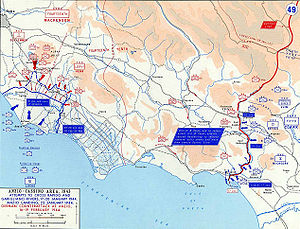Battle of Anzio
Operation Shingle
Part of: Italian campaign, World War II

Anzio bridgehead and front line in January/February 1944
Significant military operations during the Second World War in Italy
1940-1945: Air raids on Italy1940:
Attack on Taranto1943
: Operation Husky - Invasion of Italy (Baytown, Avalanche, Slapstick) - Armistice of Cassibile - Fall Axis1944
: Battle of Monte Cassino - Operation Shingle - Gotenstellung1945
: Spring Offensive
Operation Shingle (shingle is the English word for roofing shingle, shingle beach the name for a beachform formed of flat stones) was an amphibious landing operation conducted on 22 January 1944 by Allied forces in the Italian theater of war in the vicinity of Anzio and Nettuno on the Tyrrhenian Sea in central Italy. It took place at the beginning of the Battle of Monte Cassino. The operation involved mainly the US VI Corps under Major General John P. Lucas. The Allied objective was to bypass the main German defensive line in central Italy (Gustav Line), thus accelerating the advance on Rome. The operation and its subsequent engagements are also known as the Battle of Anzio.
Previous story
After units of the U.S. 5th Army and the British 8th Army landed near Salerno and in southern Italy as part of the Allied invasion of Italy in September 1943, the Allied advance became bogged down at the German Gustav Line in late 1943 - about 100 kilometers south of the psychologically important objective of Rome. Allied commanders then began planning to break the stalemate in the front line by conducting an amphibious landing operation behind the front line near Rome.
One of the biggest problems in planning the attack was the availability of landing craft, as these were to be available for other operations, such as the later Normandy landings. Originally, only so many LSTs (Landing Ship, Tank) were available that only one division could have been dropped at a time. In late December 1943, Allied commanders in Tunis decided to provide enough landing ships for two divisions.
Planning
The coastal plain 40 kilometres south of Rome at the northern end of the Pontine plain near Latina (then called Littoria) was chosen as the landing area. At its center were the coastal towns of Anzio and Nettuno. The key date landings of the operation were to be carried out by the 1st British and 3rd U.S. Infantry Divisions, supported by armored and paratrooper units, as well as Ranger and Commando units. After the successful landing, the landing convoy was to return to Naples and ferry two more divisions to the LZ. The Allied units were attached to the U.S. VI Corps under the command of John P. Lucas. The Allies expected five or six German divisions in the objective area, some in reduced strength, which could arrive spread over several days. The landing was to be prepared by attacks on Luftwaffe airfields and supply lines, and tactical air support and fighter protection would be available for the duration of the operation.
The Gustav Line defenses in the hilly area of southern Lazio between the Abruzzi and the Mediterranean coast were to be pressured several days before the landing by attacks by the U.S. 5th Army under General Mark W. Clark in order to tie up the German 10th Army there and cause the Commander-in-Chief South, Field Marshal Kesselring, to withdraw troops from the Rome area to the front. The Allied plan then was that if German units were withdrawn from the Gustav Line to fight the landing forces, the line should be attacked and broken through. Otherwise, the troops landed at Anzio were to advance on Rome through the Alban Hills and threaten to cut off the German units on the Gustav Line. If, on the other hand, the Germans had been able to muster sufficient units to defend Rome and the line, Operation Shingle would at least have ensured that German troops in central Italy would have been tied up and thus unable to take part in the fighting on other fronts.
The plan was approved on January 12, and the day of landing was fixed for January 22. Major General Lucas seemed to have little confidence in the plan or his superiors. He drew parallels with the Allies' ultimately failed Gallipoli venture in World War I (1915/16). Just like Shingle, it went back to Winston Churchill. Remarks on it can be found in Lucas's diary.
Questions and Answers
Q: What was the Battle of Anzio?
A: The Battle of Anzio was an Allied sea landing in the Italian Campaign against German forces of Anzio and Nettuno, Italy.
Q: Who was the commander of the attack in the Battle of Anzio?
A: American Major General John P. Lucas was the commander of the attack in the Battle of Anzio.
Q: What was the objective of the attack in the Battle of Anzio?
A: The objective of the attack in the Battle of Anzio was to get around German forces on the Winter Line and attack Rome.
Q: Why did the landing need to be done quickly in the Battle of Anzio?
A: The landing needed to be done quickly in the Battle of Anzio because it was made in a marshland.
Q: How did the landing surprise the Germans in the Battle of Anzio?
A: The landing surprised the Germans in the Battle of Anzio because they were not expecting it.
Q: What did the Germans do in response to the Allies' landing in the Battle of Anzio?
A: In response to the Allies' landing in the Battle of Anzio, the Germans put their guns around the beach and flooded the marsh with salt water.
Q: When was Rome captured in the Italian Campaign?
A: Rome was captured in the Italian Campaign on 4 June after the Allies got past the beaches in May.
Search within the encyclopedia